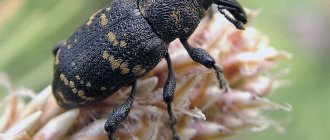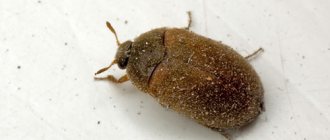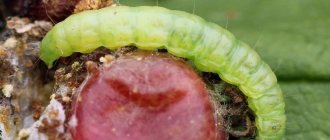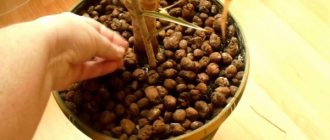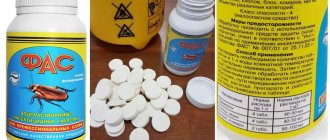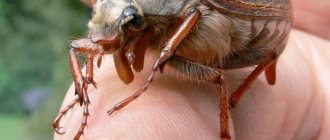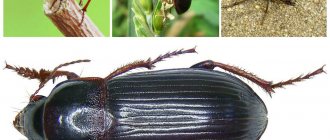The harmfulness of the striped nodule weevil
It is a widespread species of weevil. Found throughout Europe and North America. A very harmful species that damages agricultural legumes such as beans, peas, lupine, and perennial legumes. Both adult beetles and their larvae cause harm. The adults gnaw out oval-shaped pieces along the edges of the leaves. Such damage is commonly called “figure overeating.” The most dangerous are damage to the cotyledons and growing points. Damage to the root nodule weevil leads to a decrease in yield, deterioration in seed quality and a decrease in nitrogen content in plants and directly in the soil.
Peas damaged by striped nodule weevil – Sitona Lineatus
Description of the species
For etymologists, it is interesting which order the beet weevil belongs to. But it is important for gardeners and ordinary people to know how to deal with this pest.
The beet weevil (Bothynoderes punctiventris), from the family Curculionidae, is a relatively large beetle, the length of which varies between 14.5-17 millimeters. Externally, the insect is distinguished by the following characteristics:
- gray body;
- black elytra with dark spots;
- on each of the elytra there is a white tubercle;
- the pronotum is covered with short and rounded scales;
- the abdomen is gray and with black spots.
The insect's head is short and thickens near the wings. The antennae are distinguished by their geniculate shape. The oral apparatus is of the gnawing type. The legs are long and covered with fine hairs.
The beet weevil belongs to the order of Coleoptera beetles. This insect from the group of short-proboscis is noteworthy in that the external signs of the pest depend on the region of its habitat and can change. Thus, in the common weevil, the chest and head are distinguished by a yellow color, and the upper part of the body is covered with a hard brown plate.
Lifestyle
Weevils like to overwinter in the soil. Moreover, both adult individuals (imago) and larvae hibernate. Basically, pests lie at a depth of 20-25 centimeters, but in rare cases they go down to 65 centimeters. Representatives of the weevil family appear on the surface of the earth during a period when the ambient temperature rises to +10 degrees. At the same time, the gray variety of pests “wakes up” later than the others.
In the first few days after waking up, insects feed on any leaves they come across. But after satisfying their hunger, the beetles move towards food plants.
Overwintered individuals are considered the most dangerous for fruit and vegetable crops. This is explained by the fact that the beetles are experiencing severe hunger during this period, and the beets on the site have only given the first leaves. And active pests eat most of the newly emerged crop, thereby causing the death of the plant.
The beet weevil is able to quickly spread throughout the area. The beetle freely covers long distances, moving along the ground. Insects are most active on warm and sunny days. During frosts, weevils burrow back into the soil.
Reproduction
The breeding season occurs at the end of April or beginning of May. At this time, the activity of beet weevils increases. At one time, an adult female lays 200-700 eggs in the ground next to food crops. And closer to autumn, the insects die.
The incubation period lasts up to 20 days. After emergence, the larvae burrow into the soil and eat the root system of the crop. At this stage, insect development takes up to 13-25 months. To avoid infection with fungal infections and withstand the cold, the larvae are buried 2 meters into the ground. After winter ends, insects move upward, closer to the root system of fruit and vegetable plants.
In the second year of development, the pupation stage begins, which lasts 3 weeks. Young individuals appear towards the end of summer. However, in this form, pests continue to live in the ground, emerging after the onset of next spring.
Morphology of the striped nodule weevil
An adult beetle reaches a size of 3-5 mm; the color is predominantly earthy gray; pronotum brown, widened in the middle; there are white and dark stripes on the elytra; the head is equipped with a thick and short rostrum; the insect egg has a size of 0.2-0.3 mm, round in shape, smooth, a newly laid egg is yellowish-white, but after 2-3 days it acquires a blackish tint. The larva is 5 mm long, slightly curved, whitish in color with a brownish head; pupa 5-6 mm, pale yellow.
Striped nodule weevil – Sitona Lineatus
Larva of the striped nodule weevil – Sitona lineatus
Developmental biology of the striped nodule weevil
Overwintering occurs at the adult beetle stage in the surface layer of soil and under plant debris in fields where perennial legumes are cultivated. In early April, when the temperature reaches 3-5⁰C, they begin to leave their wintering areas. At a temperature of 6-8⁰C they begin to feed on perennial leguminous grasses, and with the appearance of annual shoots they switch to them without stopping feeding and lay eggs. I usually lay eggs on the soil, sometimes on the lower leaves, from which they still fall to the ground. The maximum fertility of a female is 2700 eggs. Embryonic development lasts for 7-8 days. Having hatched from the egg, the larva descends to the root and damages the nodules. The period of larval development lasts about 29-40 days. During this time, the larva is able to destroy on average from four to seven nodules. Having completed active feeding, the larva pupates in the ground at a depth of about 6-30 cm. The pupa develops over 9-13 days. In the steppe zone, insects begin to appear at the end of June. The emergence of insects lasts for more than two months. The root weevil does very well in years with warm and humid springs and summers. July-August is the most active feeding period for beetles, after which they migrate to wintering areas. They produce one generation throughout the year.
Striped nodule weevil – Sitona Lineatus
Beet weevil
Sugar beets are damaged by several types of beet weevils: common (Bothynoderes punctiventris Germ.), striped (Chromoderus fasciatus Mull.), whitish (Chromoderus declivis Ol.), oriental (Bothynoderes foveicollis Gebl.) and gray (Tanymecus palliatus F.)
Common weevil (Bothynoderes punctiventris Germ.)
The beetle is quite large in size, 12-16 mm long, grayish-brown, on the body there is a black stripe that runs obliquely along the elytra, at the end of which there is a characteristic white dot. There are black spots on the lower abdomen. Weevil larvae are white, arched with transverse wrinkles, the head is brown. During the period of development, it molts four times and goes through five instars. The eggs are yellowish-white, oval, up to 1.2-1.3 mm long.
Beetles, larvae and pupae overwinter in fields at a depth of about 25 cm. Beetles begin to emerge from wintering as soon as the soil warms up to +8-10°C (April-mid-May). Beetles reach maximum activity when the ambient temperature reaches +25°C. The emerging beetles first feed on weeds, then move on to beet crops as soon as seedlings appear. The dispersal of beetles occurs by crawling and flying. Beetle flight occurs during the hottest hours of the day.
The beetles move quickly and colonize sugar beet seedlings and seed plots. Having finished feeding, the females lay eggs in the surface layer of soil up to 1 cm. One female has from 20–30 to 200–300 eggs. After laying eggs, the beetles naturally die off.
Larvae appear from the second half of May. They quickly move inside the soil and feed on the roots of quinoa, beets, pigweed, etc., going deeper into the soil as they develop. During years of mass reproduction, one beet plant contains several dozen, and at the root of the testes there are over 100 larvae. Having finished feeding, they pupate. The young generation of beetles emerges from their pupae from late July to mid-August. In warm weather, some beetles can come to the surface of the soil, but when it gets colder they go back into the ground. The bulk of the beetles do not come to the surface and remain for the winter in the places of hatching.
Beetles and larvae are harmful.
EPV on precision seeding when detecting 0.3-0.5 beetles/m2, with conventional seeding - 2-4 beetles/m2.
One generation of the pest develops.
Main harm
Dangerous pest. The beetles eat the fork and bite the stem. When the leaves appear, they eat them too. The damage appears as jagged edges along the edges of the sheet. Dangerous until the second to fourth pair of leaves grow. In addition to chenopods, beetles feed on species from the families of amaranthaceae, purslanaceae and others.
The larvae damage plant roots. At the beginning of development, only small lateral roots are eaten, then holes in the main root are gnawed out. In young and stunted plants, the larvae can gnaw the root completely. If severe damage occurs, young plants die and thinning of crops occurs. Developed beet plants turn yellow, wither, and die in the absence of moisture. Damaged testes dry out prematurely.
Control measures
- Biological measures - among the entomophages, the egg eater caenocrepis, parasitic fungi, ground beetles, and carrion eaters are known.
- Deep plowing of a beet field in autumn after harvesting
- Treating the seeds before sowing will help protect them.
- Application of insecticides.
Striped weevil (Chromoderus fasciatus Mull.)
The color is black, the beetle is covered with dark gray scales and hairs, and there are black blurry spots on the elytra.
In spring, when the temperature on the soil surface reaches +15–17°C, adults awaken and disperse.
Eggs are laid on the roots of beet seedlings, 1-3 pieces each. The egg laying period begins in May and lasts about a month. One female lays 100-180 eggs. The larvae emerge from them on the 8-10th day. They bite into the roots, making passages in them, feed there for up to 60 days, and pupate there. Where the female gnaws out a hole, she fills it with a viscous liquid, to which soil particles stick. The bulk of the beetles come to the surface, however, some of them do not have time to complete development and remain in the roots.
Main harm
- Damaged roots are stored worse and contain less sugar.
- In late beet sowings, the larvae can cause thinning of the crop and death of seedlings.
Control measures
- It is necessary to cultivate the soil well.
- Select benign seed material.
- Application of fertilizers, cultivation of row spacing.
- Treating seeds before sowing will help protect them
- Application of insecticides
Protective measures against striped nodule weevil
Agrotechnical control measures:
- early sowing of peas;
- mandatory spatial isolation from perennial leguminous grasses;
- plowing the field after harvesting;
- crop rotation.
Biological control measures
The number of species in nature can also be limited by entomophages, predators Harpalus pubescens, Philonthuus ebeninus, parasites of adult beetles Pygostolus falcatus, Perititus labilis. The species is also affected by the fungus Mycetosporidium, and the larval stage and pupa are also affected by the green muscardine Metarrhizium anisopliae.
